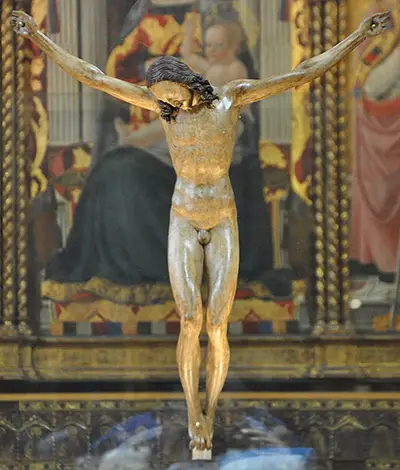There is little information available on this sculpture in the early years after it had been completed, such as in the writings of either Ascanio Condivi or Giorgio Vasari. The piece was purchased in 2008 by the Italian government and questionmarks have since been raised about the purchase, because of the doubt over who actually produced it. Several experts have suggested that actually it was produced by another Italian sculptor, Sansovino, and that therefore its value would not be as much as the €3.2 million that was paid for it to its previous owner, Giancarlo Gallino (hence its name as the Gallino Crucifix). That said, it is still a fine piece which certainly does date to the late 15th century and is of important artistic value, whoever produced it. Several items have been linked to Michelangelo in recent years, often for the potential profit or prestige that a confirmed attribution might bring.
It is perhaps the styling of Christ's body, and the lifelike nature of that, which has led some to connect the piece to Michelangelo. Sadly, this can never be enough to provide a confident attribution and there is a lack of other evidence to really put this claim forward with any real certainty. There are also a number of other crucifixes from his career which also fall roughly into this category and most Renaissance artists have sections of work which are categorised into "by" and "attributed to" in order to underline this difference. Few documents were produced on some elements of his career, and perhaps any that were have been lost in the years that have passed since, making it hard to be clear in some cases.
The Bargello Museum in Florence, Italy hosts a good selection of Renaissance art from a variety of famous names, and most does not hold any issues regarding attribution. The art museum is set within a former barracks and prison, though the architecture is stunning and entirely in keeping with the age of the collection held inside. There is St George, David and a Bust attributed to Donatello to be found here, as well as Lorenzo Ghiberti's Isaac's Sacrifice, Bacchus by Michelangelo and also a Bust of Costanza Bonarelli by Gian Lorenzo Bernini. These are some of the most important sculptures of the Italian Renaissance and so it is unsurprising that this venue hosts a large number of visitors each and every year, even though there are so many other attractions for art lovers within this cultural city. Considering his small output, the inclusion of several different Donatello sculptures are also particularly significant to followers of this period.


